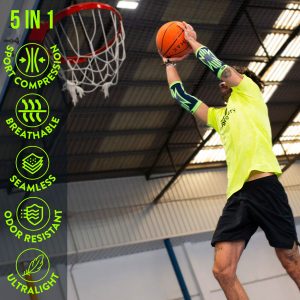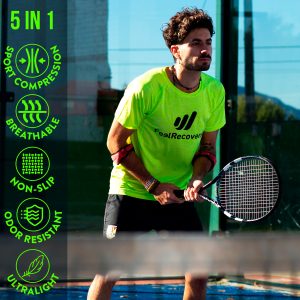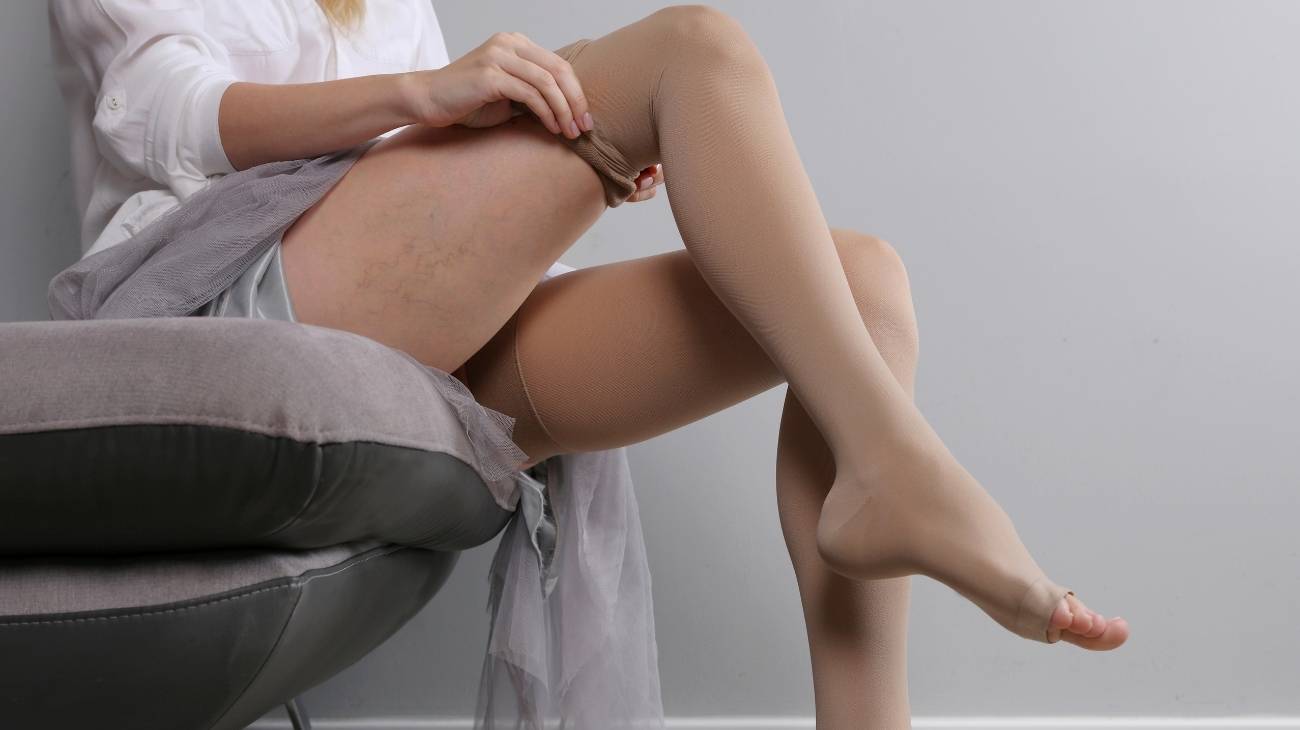Compression Sleeves
Improving sporting performance and, in turn, reducing the likelihood of muscle injuries as much as possible are undoubtedly one of the greatest desires of any athlete. Compression clothing has been developed with this intention in mind, and not only brings benefits to athletes, but also to anyone who wants to avoid injuries or speed up recovery from any ailment.
The best compression sleeves
-
2 Ankle Compression Sleeve (Black/Gray)
£17,50 -
2 Ankle Compression Sleeve (Green/Navy)
£17,50 -
2 Ankle Compression Sleeve (Pink/Bordeaux)
£17,50 -
2 Calf Compression Sleeve (Black/Gray)
£17,50 -
2 Calf Compression Sleeve (Green/Navy)
£17,50 -
2 Calf Compression Sleeve (Pink/Bordeaux)
£17,50 -
2 Elbow Compression Sleeve (Black/Gray)
£17,50 -
2 Elbow Compression Sleeve (Green/Navy)
£17,50 -
2 Elbow Compression Sleeve (Pink/Bordeaux)
£17,50 -
2 Knee Compression Sleeve (Black/Gray)
£17,50 -
2 Knee Compression Sleeve (Green/Navy)
£17,50 -
2 Knee Compression Sleeve (Pink/Bordeaux)
£17,50 -
2 Patella Knee Strap (Black/Gray)
£12,95 -
2 Patella Knee Strap (Green/Navy)
£12,95 -
2 Patella Knee Strap (Pink/Bordeaux)
£12,95 -
2 Tennis Elbow Brace (Black/Gray)
£12,95 -
2 Tennis Elbow Brace (Green/Navy)
£12,95 -
2 Tennis Elbow Brace (Pink/Bordeaux)
£12,95 -
2 Thigh Compression Sleeve (Black/Gray)
£17,50 -
2 Thigh Compression Sleeve (Green/Navy)
£17,50 -
2 Thigh Compression Sleeve (Pink/Bordeaux)
£17,50 -
Back Support Belt (Black)
£29,95 -
Back Support Belt (Green)
£29,95 -
Back Support Belt (Pink)
£29,95 -
Sacroiliac Support Belt (Black)
£21,95 -
Sacroiliac Support Belt (Green)
£21,95 -
Sacroiliac Support Belt (Pink)
£21,95 -
Shoulder Support Brace (Black)
£21,95 -
Shoulder Support Brace (Green)
£21,95 -
Shoulder Support Brace (Pink)
£21,95 -
Sport Compression Socks (1 Pair) (Black/Gray)
£17,50 -
Sport Compression Socks (1 Pair) (Green/Navy)
£17,50 -
Sport Compression Socks (1 Pair) (Pink/Bordeaux)
£17,50 -
Wrist Brace (Black/Gray)
£17,50 -
Wrist Brace (Green/Navy)
£17,50 -
Wrist Brace (Pink/Bordeaux)
£17,50
Latest reviews
What is compression clothing and what is it for?
Types of compression clothing for men and women
- Wrist braces: These are small, one-piece garments that encircle the wrist, giving extra stability to the joint so that its ligaments and tendons are not overstressed. They are usually made with a piece of Velcro to regulate the fit on the wrist.
- Elbow braces: These are cylindrical garments that fit perfectly on the spleen and adjust to the elbow. They can be found in two designs, in a single garment that fits the anatomy of the joint, or open, which are adjusted by buckles or Velcro fasteners.
- Shoulder supports: These have a generally therapeutic application. They are shaped like a splint and are intended to support the shoulder to immobilise the joint during recovery and pain. To protect this joint during physical activity, elastic compression shoulder braces are often used to offer greater mobility.
- Thigh braces: These are cylindrical garments fitted to the quadriceps and biceps femoris muscles of the legs, and are used in particular to reduce impact and vibration during activities such as walking, running or jumping, although they are also often used for patients with poor blood circulation problems.
- Knee braces: Like elbow braces, they are available in two designs, a cylindrical single-garment design that fits over the knee to provide stability during sports activities, and an open Velcro-fastening design, which is more commonly used for post-operative and rehabilitation purposes.
- Ankle braces: These are garments that fit anatomically to the ankle and are commonly used to immobilise the joint during recovery processes for sprains. For use during physical activity, compression stockings that cover the entire foot up to the calf are used.
- Back support belt: These are open garments that are fastened with Velcro fasteners on the lower back. It can be used by athletes to provide extra stability to the lower back, or for patients with herniated discs or sciatica who require extra support to keep the condition at bay. They are usually also used to protect the lower back in jobs where the back is under constant strain.
- Sacroiliac hip support belt: These are open garments that wrap around the hip and apply adjustable compression. They are widely used by people who suffer from hip problems as they improve the strength of the hip and lower back. They can also be useful to prevent injuries such as lumbago or herniated discs.
- Calf compression sleeves: These are cylindrical garments similar to a long sock, but they cover only the calf and not the foot. They can be worn by athletes in sports where a lot of vibration is generated in the legs from running and jumping, or by people who want to alleviate circulatory problems in their daily lives.
- Compression socks and stockings: These are garments made of highly elastic materials such as Spandex that provide extra pressure between 20 mmHg and 40 mmHg. Their function is to provide stability and protect the muscles and joints of the feet, ankles and calves. You can even find longer designs that go all the way up to the middle of the thighs.
Health and sports benefits of compression garments
- Improved athletic performance: Several medical studies have determined that compression garments improve the performance of athletes, since by stimulating better blood circulation, they produce a reduction in wear and tear during training or competition. In other words, the muscles will be more resistant.
- Reduces muscle fatigue: By improving blood flow, a beneficial effect is achieved that greatly reduces muscle fatigue, so that the athlete can perform for longer with less risk of contractures or cramps.
- Avoid sports injuries: Most sports injuries are muscular, and these in turn are generated by wear and tear and accumulated tension due to the impact of the actions in the sports discipline in question. The latter is minimised with compression garments that better absorb vibrations in the muscles when running or jumping.
- Accelerates muscle recovery: Wearing compression garments during an injury compacts the muscle fibres and in turn, generates better circulation, which stimulates cellular recovery when complemented with other conventional therapies such as cryotherapy and physiotherapy.
- Improves blood circulation: By compressing the muscle fibres, a more solid and compact area is achieved in which blood circulation flows much better, a factor that generates a chain reaction of benefits for the organism.
- Improved oxygenation of the blood: They allow a better assimilation of oxygen in the blood, which leads to a better quality blood flow, which in turn, oxygenates the muscle fibres much better, making them healthier as they absorb nutrients better.
- Drainage of toxins: By improving blood flow, it also allows a considerable improvement in the drainage of toxins in the body, which brings benefits to the whole body in general and not just the muscles.
- Minimises vibrations: By compacting the muscle fibres, a more impact-resistant area is achieved in which there is less impact from the vibrations generated when running or jumping, minimising the risk of injury.
- Improved postural hygiene: Compression garments such as shoulder supports or lower back braces help to improve posture, which releases tension in the back and all its nerves, reducing the possibility of cervical or lumbar pain.
- Increased stability and support: Muscles and joints where compression garments are worn get extra support in their tendons and ligaments, which improves overall stability, reducing the likelihood of sprains.
- Maintains body heat: Another important feature is that it helps to maintain body temperature during and after sporting activity, as well as being breathable. It provides comfort and warmth when practising or competing in cold weather. Compression garments are thermo-regulating for hot and cold.
- Prevents chafing and blisters: Wearing seamless compression garments in areas where there is friction on the skin, such as ankle braces or compression tights that cover the crotch, minimises the occurrence of chafing and blisters.
F.A.Q: Frequently asked questions
Best guides, tutorials & tips
Buy cheap compression sleeves for men and woman
Showing all 12 results
















































































There are no reviews yet.